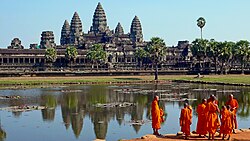
This is a list of Buddhist temples, monasteries, stupas, and pagodas in Cambodia for which there are Wikipedia articles, sorted by location.
Contents
- Kampong Cham
- Kampong Thom Province
- Kampot Province
- Kandai Province
- Phnom Penh
- Pursat Province
- Siem Reap Province
- See also
- Notes
- External links
Theravada Buddhism is the official religion of Cambodia, practiced by 95% of the population. Theravada Buddhist tradition is widespread and strong in all provinces, with an estimated 4,392 pagodas throughout the country. In Cambodia, the constitution states that "Buddhism is the state religion" and most of the people practice Theravada Buddhism.

